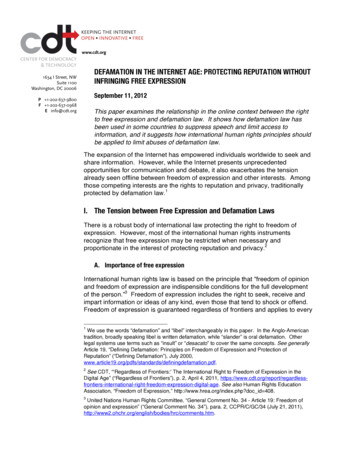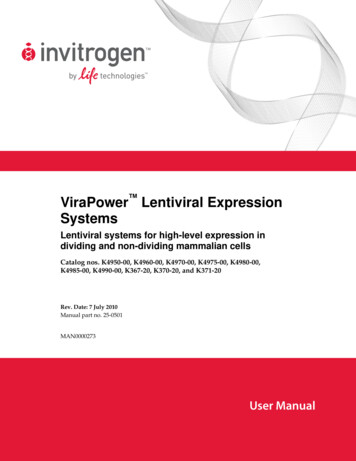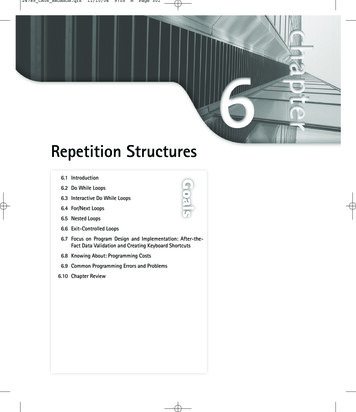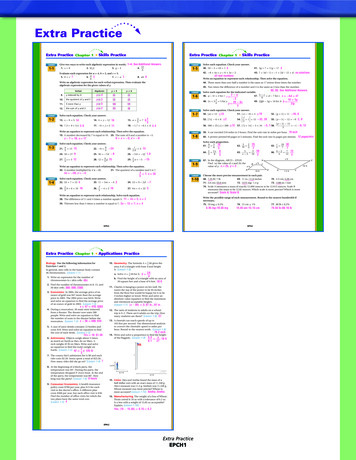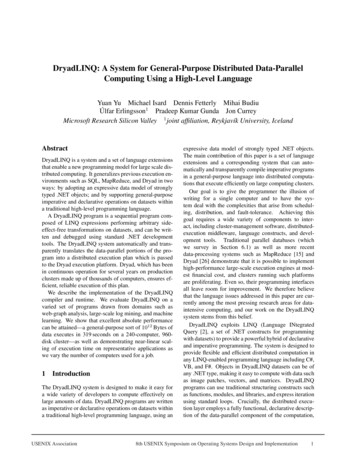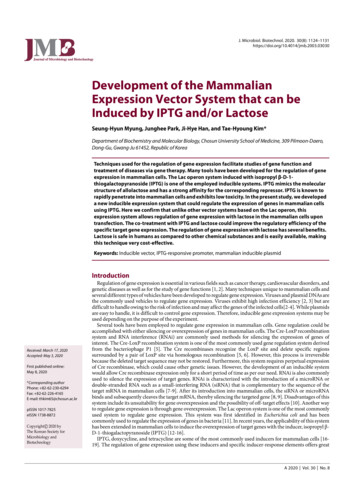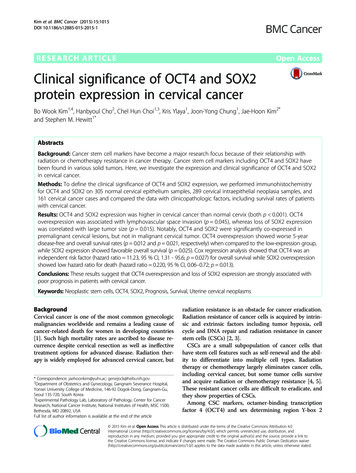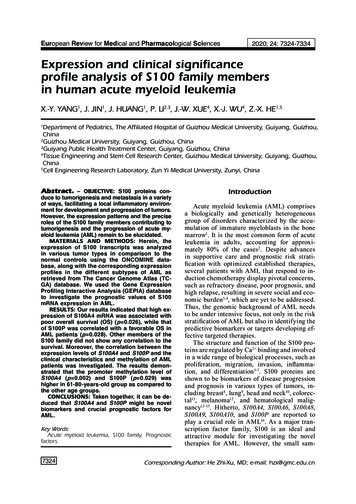
Transcription
European Review for Medical and Pharmacological Sciences2020; 24: 7324-7334Expression and clinical significanceprofile analysis of S100 family membersin human acute myeloid leukemiaX.-Y. YANG1, J. JIN1, J. HUANG1, P. LI2,3, J.-W. XUE4, X.-J. WU4, Z.-X. HE1,5Department of Pediatrics, The Affiliated Hospital of Guizhou Medical University, Guiyang, Guizhou,China2Guizhou Medical University, Guiyang, Guizhou, China3Guiyang Public Health Treatment Center, Guiyang, Guizhou, China4Tissue Engineering and Stem Cell Research Center, Guizhou Medical University, Guiyang, Guizhou,China5Cell Engineering Research Laboratory, Zun Yi Medical University, Zunyi, China1Abstract. – OBJECTIVE: S100 proteins con-duce to tumorigenesis and metastasis in a varietyof ways, facilitating a local inflammatory environment for development and progression of tumors.However, the expression patterns and the preciseroles of the S100 family members contributing totumorigenesis and the progression of acute myeloid leukemia (AML) remain to be elucidated.MATERIALS AND METHODS: Herein, theexpression of S100 transcripts was analyzedin various tumor types in comparison to thenormal controls using the ONCOMINE database, along with the corresponding expressionprofiles in the different subtypes of AML asretrieved from The Cancer Genome Atlas (TCGA) database. We used the Gene ExpressionProfiling Interactive Analysis (GEPIA) databaseto investigate the prognostic values of S100mRNA expression in AML.RESULTS: Our results indicated that high expression of S100A4 mRNA was associated withpoor overall survival (OS) (p 0.026), while thatof S100P was correlated with a favorable OS inAML patients (p 0.028). Other members of theS100 family did not show any correlation to thesurvival. Moreover, the correlation between theexpression levels of S100A4 and S100P and theclinical characteristics and methylation of AMLpatients was investigated. The results demonstrated that the promoter methylation level ofS100A4 (p 0.002) and S100P (p 0.029) washigher in 61-80-years-old group as compared tothe other age groups.CONCLUSIONS: Taken together, it can be deduced that S100A4 and S100P might be novelbiomarkers and crucial prognostic factors forAML.Key Words:Acute myeloid leukemia, S100 family, Prognosticfactors.7324IntroductionAcute myeloid leukemia (AML) comprisesa biologically and genetically heterogeneousgroup of disorders characterized by the accumulation of immature myeloblasts in the bonemarrow1. It is the most common form of acuteleukemia in adults, accounting for approximately 80% of the cases2. Despite advancesin supportive care and prognostic risk stratification with optimized established therapies,several patients with AML that respond to induction chemotherapy display pivotal concerns,such as refractory disease, poor prognosis, andhigh relapse, resulting in severe social and economic burden 3,4, which are yet to be addressed.Thus, the genomic background of AML needsto be under intensive focus, not only in the riskstratification of AML but also in identifying thepredictive biomarkers or targets developing effective targeted therapies.The structure and function of the S100 proteins are regulated by Ca 2 binding and involvedin a wide range of biological processes, such asproliferation, migration, invasion, inflammation, and differentiation 5-7. S100 proteins areshown to be biomarkers of disease progressionand prognosis in various types of tumors, including breast8, lung 9, head and neck10, colorectal11, melanoma12, and hematological malignancy13-15. Hitherto, S100A4, S100A6, S100A8,S100A9, S100A10, and S100P are reported toplay a crucial role in AML16. As a major transcription factor family, S100 is an ideal andattractive module for investigating the noveltherapies for AML. However, the small sam-Corresponding Author: He Zhi-Xu, MD; e-mail: hzx@gmc.edu.cn
Expression of S100 proteins and their clinical significance in AMLple size in some studies raised doubts about thecredibility and generalizability of the results.Although the dysregulated expression level ofS100 factors and correlation with prognosishas been reported in AML, the comprehensiveanalysis of S100 protein expression has not yetbeen carried out. Therefore, the purpose of thisstudy was to systematically investigate the expression and prognostic value of S100 familymembers with potential gene function in AMLbased on integrated large database. Also, wesystemically described the expression profilesof each S100 family member in a large number of patients by integrating analysis throughONCOMIME, GEPIA, UALCAN, and TCGAdatabase.Materials and MethodsONCOMINE DatabaseThe mRNA levels of S100 family members invarious types of cancers were determined by analysis based on the ONCOMIME database (AnnArbon, MI, USA) (http://www.oncomine.org/). Inthe present study, Student’s t-test was used to obtain a p-value for the comparison between cancerspecimens and normal control datasets. The foldchange was defined as 2 and the p-value was setat 0.01.GEPIA DatasetGEPIA (Beijing, China) is a newly developedinteractive web server for analyzing the RNAsequencing expression data of 9,736 tumors and8,587 normal samples from TCGA and the Genotype-Tissue Expression (GTEx) projects usinga standard processing pipeline (http://gepia.cancer-pku.cn/)17. It is involved in customizablefunctions, such as tumor or normal differentialexpression analysis, profiling according to thetype of neoplasms or pathological staging, patient survival analysis, genetic testing, correlation analysis, and the analysis of dimension reduction.UALCANUALCAN (Birmingham, AL, USA) is publicly available at http://ualcan.path.uab.edu. It usesTCGA level 3 RNA-seq and clinical data from 31cancer types. It also provides an easy-to-use interactive portal for the in-depth analysis of TCGAgene expression data18.ResultsDifferentiation of mRNA ExpressionLevels of the S100 Family Transcript inPan-CancerIn order to elucidate the mRNA expression ofS100 family between cancer and normal tissues inmultiple cancers, S100 family members, such asS100A1, S100A2, S100A3, S100A4, S100A5, S100A6,S100A7, S100A8, S100A9, S100A10, S100A11,S100A12, S100A13, S100A14, S100B and S100P wereexplored in human cancers using the ONCOMIMEonline database. As shown in Figure 1, the ONCOMIME database consists of a total of 443, 429, 436,403, 394, 337, 414, 438, 420, 446, 408, 438, 437, 342,456, and 438 unique analyses including S100A1S100P genes, respectively. Interestingly, S100A5,S100A7, and all S100 family members were significantly downregulated or upregulated in a majorityof human cancers. The expression of seven S100family members were upregulated in most of thecancers: upregulated vs. downregulated members(S100A2 33:10; S100A6 18:13; S100A7 9:0; S100A1029:21; S100A11 54:15; S100A13 17:7; S100P 38:25)(Figure 1). In addition, nine of the S100 family members were downregulated in the majority of cancers:unregulated vs. downregulated members (S100A14:19; S100A3 6:9; S100A4 17:22; S100A5 0:1; S100A810:29; S100A9 12:21; S100A12 4:20; S100A14 13:22;S100B 2:18) (Figure 1). Intriguingly, the expressionof S100A2, S100A11, and S100P mRNA increased in16 vs. 0 cases, 54 vs. 15 cases, and 38 vs. 25 cases incolorectal cancer. In lymphoma cancer, the expression of S100A4, S100A6, S100A11, and S100A13 geneswas unregulated. In lung carcinoma, the expressionof S100A3, S100A4, S100A8, and S100A4 was significantly downregulated in 8, 12, 8, and 6 studies,respectively (Figure 1). In leukemia, three studiesshowed that S100A4 was upregulated, and three studies showed it was downregulated. S100A6, S100A8,S100A9, S100A11, S100A12 and S100P were downregulated, while S100A13 was upregulated. However, the other members did not differ significantly inleukemia, as assessed in the validated studies.Expression Levels of S100 FamilyMembers in Human AMLWe utilized the GEPIA dataset to compare themRNA expression of S100 family between AMLand normal blood samples. The gene expression profile analysis demonstrated that the levelof S100A4, S100A6, S100A8, S100A9, S100A10,S100A12, and S100B was higher in AML than innormal blood samples (Figure 2A).7325
X.-Y. Yang, J. Jin, J. Huang, P. Li, J.-W. Xue, X.-J. Wu, Z.-X. HeFigure 1. mRNA expression levels of S100 calcium-binding protein family members in human cancers. The mRNA expression of the GATA family members (cancer vs. normal tissue) in pan-cancers analyzed using the ONCOMINE database. Thenumber in the colored cell represents the number of analyses meeting thresholds. The cell color was defined as the gene rankpercentile in the study. The intense red (overexpression) or blue (underexpression) indicates a significantly overexpressed orunderexpressed gene, respectively.Figure 2. RNA-seq profile of S100 family members in human AML and normal samples. A, The expression after normalization by log2 (TPM 1) for log-scale as compared to the tumor and normal samples in AML. B-E, Box plot of the expression profile of the S100 family members in AML and normal blood samples. A t-test was used to compare the difference inexpression between tumor and normal tissues.7326
Expression of S100 proteins and their clinical significance in AMLIn addition, the box plots of the RNA-seq expression in 173 AML blood samples vs. 70 normal blood samples demonstrated that S100A4,S100A8, S100A9, S100A10, and S100A12 was significantly increased (p 0.01, Figure 2B, 2C, and2D). Moreover, the transcription level of S100A1,S100A13, and S100P was decreased significantlyin AML vs. normal samples (p 0.01, Figure 2Band 2E). However, other S100 family membersdid not reveal any statistical significance in AMLblood samples as compared to normal blood samples, including S100A2, S100A3, S100A5, S100A6,S100A7, S100A11, S100A14, and S100B (Figure2B, 2C, 2D, and 2E).Expression Analysis Of S100 FamilyMembers in Different Molecular Subtypesof Human AMLMorphologically, AML was divided into eightgroups in the French-American-British classification (FAB) system (FAB M0-M7), wherein thecells are classified as no/minimal minimum differentiation signs (FAB M0/M1) or a mature phenotype (FAB M5-7)19,20. To further understand theexpression of S100 family members between dif-ferent subtypes of AML, we analyzed the AMLsubtypes from the TCGA database. The resultsshowed that S100A1 was highly expressed in M3,M5, and M7, especially M7, but lowly expressedin M0, M1, M2, M4, and M6, especially M6 (Figure 3A, Supplementary Table I). The expressionof S100A2 was highly expressed in M1, M5, M6and M7 and lowly expressed in M0, M2, M3 andM4. However, statistically significant differenceswere not detected in the expression between eachsubtype group (Figure 3A, Supplementary Table II). S100A3 was significantly overexpressedin M6 as compared to other molecular subtypes,especially M0, M1, and M2 (Figure 3B, Supplementary Table III).S100A4 was highly expressed in M4 and M5,and lowly expressed in M0, M1, M2, M3, M6,and M7 (Figure 3A, Supplementary Table IV).Similar results were observed for S100A6 andS100A8 (Figure 3C and D, Supplementary TablesVI and VII). S100A5 was highly expressed in M4,M5, M6, and M7, especially M7, while low expression was detected in M0, M1, M2, and M3,especially M2 (Figure 3C, Supplementary TableV). S100A7 was expressed in M7 and not in otherFigure 3. Box plots representing the mRNA expression levels of the S100 family members in various classes of AML inthe TCGA database.7327
X.-Y. Yang, J. Jin, J. Huang, P. Li, J.-W. Xue, X.-J. Wu, Z.-X. Hesubtypes (Figure 3D). S100A9 and S100A10 werehighly expressed in M4 and M5, while showeda low expression in M0, M1, M2, M3, M7, andwere not expressed in M6 (Figure 3E, Supplementary Table VIII and IX). S100A11 was highlyexpressed in M3, M4, and M5 and lowly in M0,M1, M2, M6, and M7 (Figure 3F, SupplementaryTable X).S100A12 was highly expressed in M4 and M5,while lowly in M0, M1, M2, M3, M6, and M7,especially M3 (Figure 3F, Supplementary TableXI). S100A13 was upregulated in M1, M3, M5, andM6 and downregulated in M0, M2, M4, and M7(Figure 3G, Supplementary Table XII). S100A14was lowly expressed in M5, while no expressionwas detected in M0, M1, M2, M3, and M4 andhigh expression was observed in M6 and M7(Figure 3G). S100B was highly expressed in M3,while the other subtypes were lowly expressed(Figure 3H, Supplementary Table XIII). S100Pwas highly expressed in M3 and M7, and lowlyin the other subtypes (Figure 3H, SupplementaryTable XIV). The results showed that the members of the S100 family differentially expressedin each subtype of AML, which might be due tothe heterogeneity of the subtypes. Taken together,these findings provided the basis for studying theexpression patterns and functions of S100 familymembers in various subtypes of AML.Prognostic Values of S100 FamilyMembers in Human AMLNext, we proceeded to determine whetherS100 family members were associated with theprognosis of human AML patients using GEPIA databases. Interestingly, the increased levelof S100A4 was associated with poor OS in AML(Hazard ratio (HR) 1.9; p 0.026, Figure 4), whiledecreased S100P was associated with poor OS(HR 0.53; p 0.028, Figure 4). However, statistical significance was not detected for S100A1(HR 1.1; p 0.83), S100A2 (HR 1.2; p 0.52),S100A3 (HR 0.68; p 0.17), S100A5 (HR 1.1;p 0.7), S100A6 (HR 1.5; p 0.15), S100A8(HR 1.3; p 0.3), S100A9 (HR 1.5; p 0.18),S100A10 (HR 1.4; p 0.21), S100A11 (HR 1.2;p 0.48), S100A12 (HR 1.4; p 0.26), S100A13(HR 1.1; p 0.78), and S100B (HR 0.98; p 0.94)(Figure 4). The GEPIA databases did not providesurvival analysis results of S100A7 and S100A14as their expression was not detected in the majority of the molecular subtypes of AML. Hence,highly expressed S100A4 and lowly expressedS100P is correlated with the prognosis of AML.7328Correlation between S100A4and S100P expression and clinicalcharacteristics of AML patientsThe above analysis demonstrated that S100A4and S100P is a valuable molecular marker for predicting the prognosis in AML. In addition, the correlation between S100A4 and S100P expression levels and clinical characteristics of AML patients wasanalyzed. Clinical features, including age, FLT3mutation, PML/RAR-fusion, gender, RAS activation, and patients’ race, were analyzed. The resultsshowed that the expression of S100A4 did not differsignificantly with respect to these clinical characteristics (Figure 5A). However, S100P was highlyexpressed in AML patients without FLT3 mutationas compared to those with FLT3 mutation (p 0.019,Figure 5B). Furthermore, FLT3 and S100P werenegatively correlated (R -0.26, p 0.00061, Figure5C). Next, the correlation analysis between S100A4and S100P expression levels and the methylation ofAML patients demonstrated that the promoter methylation level of S100A4 and S100P was higher in the61-80-year-old group (Figure 6A-B). Consequently,the expression of S100P in AML was found to benegatively correlated with that of FLT3. In addition,the high expression of S100A4 and S100P in AMLpatients of the 60-81-year-old group was related tomethylation, which provided new clinical prognostic indicators for the specific age group.DiscussionS100 has been widely recognized as an importantfamily of transcription factors that play a pivotal rolein a variety of human tumors21,22. This study is the firstto investigate the mRNA expression and prognosticvalues of different S100 family members in AML.The current findings would contribute to the existingknowledge, enhance therapeutic strategies, and improve the accuracy of prognosis in AML patients.We also found that the level of S100A1, S100A13,and S100P was downregulated in AML patients ascompared to normal blood samples. However, thelevel of S100A4, S100A8, S100A9, S100A10, andS100A12 was upregulated in AML. The expressionof other S100 proteins, including S100A2, S100A3,S100A5, S100A6, S100A7, S100A11, S100A14, andS100B mRNA showed no significant differencebetween the patients with AML and normal bloodsamples. The results revealed that some S100 family members showed a remarkable difference inthe mRNA expression between AML patients andnormal blood samples.
Expression of S100 proteins and their clinical significance in AMLFigure 4. Prognostic values of the S100 family members in AML. OS is selected as a terminal event for the pooled Kaplan–Meier survival analysis. The median expression is set as a separate line for each S100 family member. A p-value 0.05 wasconsidered statistically significant.7329
Figure 5. Correlation between the expression level of S100A4 and S100P genes in AML and age, FLT3 mutation,gender, race, RAS activation, and PML/RAR-fusion status. A, S100A4 expression with respect to age, FLT3 mutation, gender, race, RAS activation, and PML/RAR-fusion status. B, S100P expression with respect to ages, FLT3mutation, gender, race, RAS activation, and PML/RAR-fusion status. C, Correlation between the expression levelof S100P and FLT3 in AML.7330
Expression of S100 proteins and their clinical significance in AMLFigure 6. Promoter methylation level of S100A4 and S100P in AML. A, S100A4 expression with respect to race, age, andgender. B, S100P expression with respect to race, age, and gender.Hitherto, in clinical samples of patients withAML, S100A4 has been researched in both patientswith AML and chronic myeloid leukemia (CML).The expression level of S100A4 mRNA in 52 children patients with AML was 3-fold higher thanthat in the control groups23,24. The current resultfor S100A4 was consistent with that previously reported. Furthermore, the GEPIA datasets showedthat S100A4 expression was higher in AML thanin normal blood samples. UALCAN datasets alsoshowed that S100A4 was maximally expressed inM5. Based on the GEPIA datasets, we identifiedthe prognostic value of S100A4 in AML patientsand found that a high S100A4 expression was significantly associated with poor OS in AML.In hematological malignancies, the expressionlevel of S100A6 was elevated in AML25. The current result for S100A6 was consistent with that previously reported. Compared to poorly differentiatedAML (FAB M0 and M1), S100A8 and S100A9 werehighly expressed in myelomonocytic and monocyticAMLs (FAB M4 and M5)15. In AML patients, elevated S100A8 and S100A9 expression levels werealso found in plasma as compared to healthy individuals. In addition, the high level of expression ofS100A8 was related to poor prognosis in AML26-28.The expression analysis in the current study showedthat the mRNA levels of S100A8 and S100A9 wereincreased in AML as compared to those in normalblood samples. The levels were also high in the leukemia subtypes M4 and M5, which was associatedwith a poor prognosis in AML, albeit without statistical significance. In AML, S100A10 is relevantto coagulopathy in patients with FAB M329,30. It isknown that the molecule protects primary AML andacute lymphocytic leulemia (ALL) blasts from chemotherapy31. Therefore, high expression of S100A10mRNA was found in pediatric B-cell ALL, andthese elevated levels were also in connection withearly recurrence32. In the current study, the high expression of S100A10 was observed in AML, especially in M3, M4 and M5. However, high S100A10expression was not associated with poor OS inAML. High expression S100P was associated withcell proliferation, metastasis, and carcinogenesis33-35.However, increased expression levels of S100P appear to be beneficial in patients with AML. Ishii etal36 reported that S100P was upregulated maximallywhen treated with cytokines in AML cell lines (HL60, THP-1, NB4). Therefore, the induction of S100Pexpression might be a feasible method to offset thedifferentiation block in AML. Moreover, the highexpression of S100P contributes positively to a favorable prognosis16. The survival analysis indicated7331
X.-Y. Yang, J. Jin, J. Huang, P. Li, J.-W. Xue, X.-J. Wu, Z.-X. Hethat the elevated level of S100P mRNA in AML wassignificantly associated with improved OS in AML,thereby suggesting the tumor-suppressive role ofS100P in AML.The 5-year OS of AML patients aged 60-yearsold was still 10%37. Reportedly, the median survival of 65-year-old patients receiving anti-leukemiatreatment was 6 months, and the 5-year survivalrate was 5%38. The refractory/early relapsed (Ref/eRel) AML in patients 60-years-old is a medicalrequisite in the salvage setting, wherein outcomesare poor39. Consequently, treating elderly AMLpatients is challenging. Aberrant promoter DNAmethylation is the main mechanism of the development of leukemia, including AML40. In addition,decitabine (DAC) and azacytidine (AZA), nucleoside analogues that inhibit DNA methylation, haveshown clinical efficacy in the treatment of AML,emphasizing the epigenetic regulation in AML41.The current results demonstrated that the promotermethylation level of S100A4 and S100P was higherin 61-80-years-old group as compared to the otherage groups. These findings indicated that S100A4and S100P expression was relevant to the promotermethylation, which is a valuable biomarker for predicting poor prognosis and demethylation therapyin 61-80-years-old AML patients.ConclusionsUnderstand comprehensively the S100 family members on the diagnosis and prognosis ofAML, patients may have a guiding significance.Our study indicated that the upregulated expression of S100A4 and downregulated expression ofS100P plays a major role in AML tumorigenesisaccording to the integrative databases and bioinformatics analysis. Furthermore, S100A4 andS100P, rather than other S100 family members,might serve as potential prognostic biomarkersand targets for new therapies of AML. Althoughadditional clinical investigations are essential,this study has provided an insight into the prognostic role of S100A4 and S100P in AML.AcknowledgmentsThis project was supported by the National Natural ScienceFoundation of China (No. 81572472 to Xinjun Wu), Scienceand Technology Plan Project of Guizhou Province (GrantNo. 2016-7240 to Xiaoyan Yang and No. 2019-5406 toZhixu He), and 2017 Academic Seedling Cultivation andInnovation Exploration Project of Guizhou Medical University (Grant No. 2017-5718 to Xiaoyan Yang).7332Authors’ ContributionsXiaoyan Yang contributed to the data acquisition, analysis,and manuscript draft; Xiaoyan Yang, Jin Jiao, Huang Jing,Xue Jianwei, Xijun Wu, and Peng Li prepared the figures;Zhixu He contributed to the study design. The final manuscript was reviewed by Zhixu He and approved by all thelisted authors.Conflict of InterestsThe authors declare that they have no conflict of interests.References1) Löwenberg B, Rowe JM. Introduction to the reviewseries on advances in acute myeloid leukemia(AML). Blood 2016; 127: 1.2) Siegel RL, M iller KD, Jemal A. Cancer statistics,2019. CA Cancer J Clin 2019; 69: 7-34.3) Short NJ, R ytting ME, Cortes JE. Acute myeloidleukemia. Lancet 2018; 392: 593-606.4) Döhner H, Weisdorf DJ, Bloomfield CD. Acutemyeloid leukemia. N Engl J Med 2015; 373:1136-11525) Donato R, C annon BR, Sorci G, Riuzzi F, Hsu K,Weber DJ, Geczy CL. Functions of S100 proteins.Curr Mol Med 2013; 13: 24-57.6) L eclerc E, Heizmann CW. The importance of Ca2 /Zn2 signaling S100 proteins and RAGE intranslational medicine. Front Biosci 2011; 3:1232-1262.7) Hermann AF, Donato R, Weiger TM, Chazin WJ.S100 calcium binding proteins and ion channels.Front Pharmacol 2012; 3: 67.8) Zhang S, Wang Z, L iu W, L ei R, Shan J, L i L, WangX. Distinct prognostic values of S100 mRNAexpression in breast cancer. Sci Rep 2017; 7:39786.9) Wang T, Huo X, Chong Z, K han H, L iu R, Wang T.A review of S100 protein family in lung cancer.Clin Chim Acta 2018; 476: 54-59.10) L ee J, Wysocki PT, Topaloglu O, M aldonado L, BraitM, Begum S, Moon D, K im MS, C alifano JA, Sidran sky D. Epigenetic silencing of S100A2 in bladderand head and neck cancers. Oncoscience 2015;2: 410-418.11) Moravkova P, Kohoutova D, Rejchrt S, CyranyJ, Bures J. Role of S100 proteins in colorectalcarcinogenesis. Gastroenterol Res Pract 2016;2016: 2632703.12) Xiong TF, Pan FQ, L i D. Expression and clinicalsignificance of S100 family genes in patients withmelanoma. Melanoma Res 2019; 29: 23-29.13) Nidhi A, Tawatchai P, Snehal P, B ayerl MG, Ser han A, B harat N, U rvashi S, Sumire K, YingyongC, Swerdlow SH. Expression of S100 protein inCD4-positive T-cell lymphomas is often associ-
Expression of S100 proteins and their clinical significance in AMLated with t-cell prolymphocytic leukemia. Am JSurg Pathol 2015; 39: 1679-1687.14) Prieto D, Sotelo N, Seija N, Sernbo S, A breu C,Durán R, Gil M, Sicco E, Irigoin V, Oliver C.S100-A9 protein in exosomes from chronic lymphocytic leukemia cells promotes NF-κB activityduring disease progression. Blood 2017; 130:777-788.15) L aouedj M, Tardif MR, Gil L, R aquil MA, L acha abA, Pelletier M, Tessier PA, B arabé F. S100A9 induces differentiation of acute myeloid leukemia cellsthrough TLR4. Blood 2017; 129: 1980-1990.16) Brenner AK, Bruserud Ø. S100 Proteins in AcuteMyeloid Leukemia. Neoplasia 2018; 20: 11751186.17) Tang Z, L i C, K ang B, G ao G, L i C, Zhang Z. GEPIA: a web server for cancer and normal geneexpression profiling and interactive analyses.Nucleic Acids Res 2017; 45: W98-W102.18) Chandrashek ar DS, B ashel B, B al asubramanya SAH,Creighton CJ, Varambally S. UALCAN: a portal forfacilitating tumor subgroup gene expression andsurvival analyses. Neoplasia 2017; 19: 649-658.19) Goldman SL, H assan C, K hunte M, Soldatenko A,Jong Y, A fshinnekoo E, M ason CE. Epigeneticmodifications in acute myeloid leukemia: prognosis, treatment, and heterogeneity. Front Genet2019; 10: 133.20) Kouchkovsky ID, A bdulhay M. Acute myeloid leukemia: a comprehensive review and 2016 update. Blood Cancer J 2016; 6: e441.21) Bresnick AR, Weber DJ, Zimmer DB. S100 proteinsin cancer. Nat Rev Cancer 2015; 15: 96-109.22) Chen H, Xu C, Jin Q, L iu Z. S100 protein familyin human cancer. Am J Cancer Res 2014; 4:89-115.23) Steinbach D, Pfaffendorf N, Wittig S, GruhnB. PRAME expression is not associated withdown-regulation of retinoic acid signaling in primary acute myeloid leukemia. Cancer GenetCytogenet 2007; 177: 51-54.24) Xu Y, Rong LJ, M eng SL, Hou FL, Zhang JH, Pan G.PRAME promotes in vitro leukemia cells deathby regulating S100A4/p53 signaling. Eur RevMed Pharmacol Sci 2016; 20: 1057-1063.25) C al abretta B, K aczmarek L, M ars W, Ochoa D,Gibson CW, Hirschhorn RR, Baserga R. Cell-cycle-specific genes differentially expressed in human leukemias. Proc Natl Acad Sci USA 1985;82: 4463-4467.26) Nicol as E, R amus C, Berthier S, A rlotto M, Boua mrani A, L efebvre C, M orel F, G arin J, I frah N,Berger F. Expression of S100A8 in leukemic cellspredicts poor survival in de novo AML patients.Leukemia 2011; 25: 57-65.27) Yang L, Yang M, Zhang H, Wang Z, Yu Y, X ie M,Zhao M, L iu L, C ao L. S100A8-targeting siRNAenhances arsenic trioxide-induced myeloid leukemia cell death by down-regulating autophagy.Int J Mol Med 2012; 29: 65-72.28) Yang XY, Zhang MY, Zhou Q, Wu SY, Zhao Y, GuWY, Pan J, Cen JN, Chen ZX, Guo WG. High expression of S100A8 gene is associated with drugresistance to etoposide and poor prognosis inacute myeloid leukemia through influencing theapoptosis pathway. Onco Targets Ther 2016; 9:4887-4899.29) Paul A, Patricia AM, Jason NB, Robert SL, DavidMW. Regulation of S100A10 by the PML-RARalpha oncoprotein. Blood 2011; 117: 4095-4105.30) Huang D, Yang Y, Sun J, Dong X, Wang J, L iuH, L u C, Chen X, Shao J, Yan J. Annexin A2S100A10 heterotetramer is upregulated by PML/RARalpha fusion protein and promotes plasminogen-dependent fibrinolysis and matrix invasion in acute promyelocytic leukemia. Front Med2017; 11: 410-422.31) K remer KN, A mel D, Mcgee-L awrence ME, Philips RL,Hess AD, Smith BD, Wijnen AJ, K arp JE, K aufmannSH, Westendorf JJ. Osteoblasts protect AML cellsfrom SDF-1-induced apoptosis. J Cell Biochem2014;115: 1128-1137.32) Gopal akrishnapill ai A, Kolb EA, Dhanan P, M asonRW, N apper A, B arwe SP. Disruption of annexin II/p11 interaction suppresses leukemia cell binding, homing and engraftment, and sensitizesthe leukemia cells to chemotherapy. PLoS One2015; 10: e0140564.33) Gross SR, Sin CG, B arraclough R, Rudl and PS.Joining S100 proteins and migration: for betteror for worse, in sickness and in health. Cell MolLife Sci 2014; 71: 1551-1579.34) A rumugam T, Simeone DM, Van GK, Logsdon CD.S100P promotes pancreatic cancer growth, survival, and invasion.Clin Cancer Res 2005; 11:5356-5364.35) Jiang H, Hu H1, L in F, L im YP, Hua Y, Tong X,Zhang S. S100P is overexpressed in squamouscell and adenosquamous carcinoma subtypesof endometrial cancer and promotes cancer cellproliferation and invasion. Cancer Invest 2016;34: 477-488.36) Ishii Y, K asuk abe T, Honma Y. Immediate up-regulation of the calcium binding protein S100P andits involvement in the cytokinin-induced differentiation of human myeloid leukemia cells. BiochimBiophys Acta 2005; 1745: 156-165.37) Scappaticci GB, M arini BL, N achar VR, Uebel JR,Vul a j V, Crouch A, Bixby DL, Talpaz M, PerissinottiAJ. Outcomes of previously untreated elderlypatients with AML: a propensity score-matchedcomparison of clofarabine vs. FLAG. Ann Hematol 2018; 97: 573-584.38) Chen Y, Yang T, Zheng X, Yang X, Zheng Z, Zheng J,L iu T, Hu J. The outcome and prognostic factorsof 248 elderly patients with acute myeloid leukemia treated with standard-dose or low-intensityinduction therapy. Medicine 2016; 95: e4182.39) R avandi F, Ritchie EK, S ayar H, L ancet JE, CraigMD, Vey N, Strickl and SA, Schiller GJ, JabbourE, Pigneux A, Horst HA, Récher C, K limek VM,7333
X.-Y. Yang, J. Jin, J. Huang, P. Li, J.-W. Xue, X.-J. Wu, Z.-X. HeCortes JE, C arell a AM, Egyed M, K rug U, Fox JA,Craig AR, Ward R, Smith JA, Acton G, K antarjianHM, Stuart RK. Phase 3 results for vosaroxin/cytarabine in the subset of patients 60 yearsold with refractory/early relapsed acute myeloidleukemia. Haematologica 2018; 103: e514-e518.40) X ia Y, Hong Q, Chen X, Ye H, Fang L, Zhou A,G
online database. As shown in Figure 1, the ONCO-MIME database consists of a total of 443, 429, 436, 403, 394, 337, 414, 438, 420, 446, 408, 438, 437, 342, 456, and 438 unique analyses including - S100A1 S100P genes, respectively. Interestingly, , S100A5 S100A7, and all S100 family members were signifi-cantly downregulated or upregulated in a .



